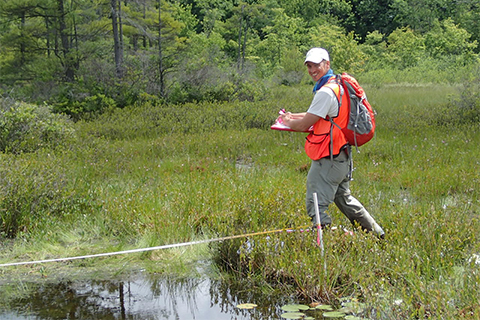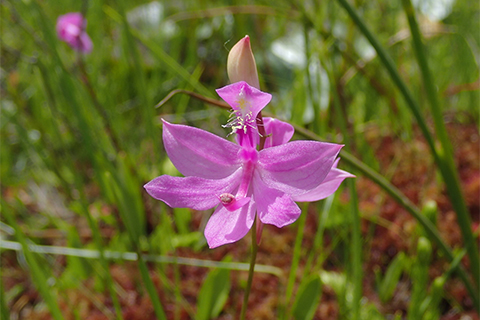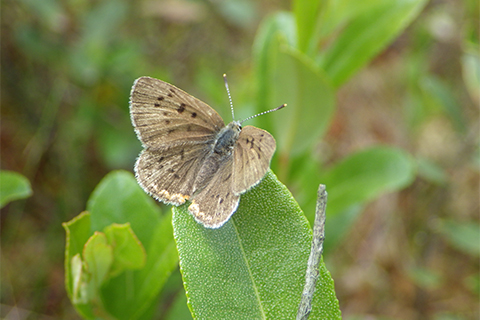Although climate change may be more evident in some places, such as the Arctic, no place is considered immune to its effects.
Over the past 110 years, Pennsylvania has undergone a long-term warming trend of almost 2 degrees Fahrenheit and an overall increased trend in precipitation.
Models show this pattern will continue into the future at an accelerated rate.
Given these projected effects, it is likely that the plants, animals, and landscape in Pennsylvania will be impacted by climate change.
The challenge for conservation managers is how to adapt and mitigate.
Planning to Address Climate Change

PNHP biologist, Scott Schuette, is sampling peatland mosses along a permanent transect. Photo by Mary Ann Furedi
Climate change will likely alter the distribution and abundance of plant and animal species in the commonwealth. Pennsylvania may even gain new species from surrounding states as ranges shift.
As part of its Climate Change Adaptation and Mitigation Plan (PDF), DCNR is working with partners to review and expand monitoring to ensure that changes in natural communities, species distribution, and populations are detected.
Data collected will inform conservation practices and priorities -- including protecting land and managing it -- to create a system of habitats that would allow species to move north and to higher elevations.
Monitoring Vulnerable Habitat
The grass pink orchid is one target plant being monitored through the peatlands project. Photo by Mary Ann Furedi
Biologists from the Pennsylvania Natural Heritage Program (PNHP) currently are monitoring to better understand how peatlands are changing, possibly in response to climate change.
Peatlands are a unique group of wetlands generally found at higher elevations. They are typically cooler and provide a special environment that supports plants normally found farther north in the U.S. They provide habitat for some of Pennsylvania’s rarest bird species.
In 2010, PNHP established a long-term monitoring network that included targeting plant species believed to be vulnerable at 30 sites. They returned to all of the sites over the past several years, and are beginning to analyze data to determine what, if any, changes have occurred during the time between the sampling.
What Species are Vulnerable?
The bog copper is found in cranberry bogs and is vulnerable to climate change. Photo by Pete Woods
A beginning step for agencies responsible for conservation is to determine those species most vulnerable and the factors that influence that vulnerability.
To contribute, PNHP biologists are using the Climate Change Vulnerability Index.
Assessments continue, but so far, more than 85 species in Pennsylvania have been examined to understand their sensitivity and exposure to climate change related factors. Some of those species include:
- Eastern hellbender
- White-fringed orchid
- Bog turtle
- Golden-winged warbler
Findings from these projects and other monitoring efforts will help guide the future management of natural resources.
What Can Citizens Do?
Learn more about climate change this month by watching National Geographic’s new film, “Paris to Pittsburgh.”
As you are doing your garden planning this year, check information on iconservePA about incorporating native plants, which provide food and habitat for wildlife.
Be a citizen scientist by participating in the Audubon Christmas Bird Count. Find locations on the DCNR Calendar of Events or check the Audubon map.
This information was gathered from a story by PNHP ecologist Mary Ann Furedi in the most recent Wild Heritage News. Subscribe to keep up with information about conserving biodiversity in Pennsylvania.